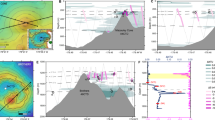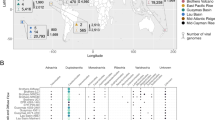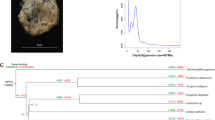Abstract
Chemolithoautotrophic Epsilonproteobacteria are ubiquitous in sulfidic, oxygen-poor habitats, including hydrothermal vents, marine oxygen minimum zones, marine sediments and sulfidic caves and have a significant role in cycling carbon, hydrogen, nitrogen and sulfur in these environments. The isolation of diverse strains of Epsilonproteobacteria and the sequencing of their genomes have revealed that this group has the metabolic potential to occupy a wide range of niches, particularly at dynamic deep-sea hydrothermal vents. We expand on this body of work by examining the population genomics of six strains of Lebetimonas, a vent-endemic, thermophilic, hydrogen-oxidizing Epsilonproteobacterium, from a single seamount in the Mariana Arc. Using Lebetimonas as a model for anaerobic, moderately thermophilic organisms in the warm, anoxic subseafloor environment, we show that genomic content is highly conserved and that recombination is limited between closely related strains. The Lebetimonas genomes are shaped by mobile genetic elements and gene loss as well as the acquisition of novel functional genes by horizontal gene transfer, which provide the potential for adaptation and microbial speciation in the deep sea. In addition, these Lebetimonas genomes contain two operons of nitrogenase genes with different evolutionary origins. Lebetimonas expressed nifH during growth with nitrogen gas as the sole nitrogen source, thus providing the first evidence of nitrogen fixation in any Epsilonproteobacteria from deep-sea hydrothermal vents. In this study, we provide a comparative overview of the genomic potential within the Nautiliaceae as well as among more distantly related hydrothermal vent Epsilonproteobacteria to broaden our understanding of microbial adaptation and diversity in the deep sea.
Similar content being viewed by others
Log in or create a free account to read this content
Gain free access to this article, as well as selected content from this journal and more on nature.com
or
Accession codes
Accessions
GenBank/EMBL/DDBJ
References
Alain K, Zbinden M, Le Bris N, Lesongeur F, Quérellou J, Gaill F et al (2004). Early steps in microbial colonization processes at deep-sea hydrothermal vents. Environ Microbiol 6: 227–241.
Anderson I, Sikorski J, Zeytun A, Nolan M, Lapidus A, Lucas S et al (2011). Complete genome sequence of Nitratifractor salsuginis type strain (E9I37-1). Stand Genomic Sci 4: 322–330.
Bose M, Barber RD . (2006). Prophage Finder: a prophage loci prediction tool for prokaryotic genome sequences. In Silico Biol 6: 223–227.
Boucher Y, Douady CJ, Papke RT, Walsh DA, Boudreau MER, Nesbø CL et al (2003). Lateral gene transfer and the origins of prokaryotic groups. Annu Rev Genet 37: 283–328.
Brazelton WJ, Mehta MP, Kelley DS, Baross JA . (2011). Physiological differentiation within a single-species biofilm fueled by serpentinization. mBio 2: e00127–11.
Brochier-Armanet C, Forterre P . (2007). Widespread distribution of archaeal reverse gyrase in thermophilic bacteria suggests a complex history of vertical inheritance and lateral gene transfers. Archaea 2: 83–93.
Butterfield DA, Nakamura K, Takano B, Lilley MD, Lupton JE, Resing JA et al (2011). High SO2 flux, sulfur accumulation, and gas fractionation at an erupting submarine volcano. Geology 39: 803–806.
Butterfield DA, Roe KK, Lilley MD, Huber JA, Baross JA, Embley RW et al (2004). Mixing, reaction, and microbial activity in the sub-seafloor revealed by temporal and spatial variation in diffuse flow vents at Axial Volcano. In Wilcock WSD, DeLong EF, Kelley DS, Baross JA, Cary SC (eds) The Subseafloor Biosphere at Mid-Ocean Ridges. American Geophysical Union: Washington, DC, pp 269–289.
Cadillo-Quiroz H, Didelot X, Held NL, Herrera A, Darling A, Reno ML et al (2012). Patterns of gene flow define species of thermophilic archaea. PLoS Biol 10: e1001265.
Campbell BJ, Engel AS, Porter ML, Takai K . (2006). The versatile epsilon-proteobacteria: key players in sulphidic habitats. Nat Rev Microbiol 4: 458–468.
Campbell BJ, Jeanthon C, Kostka JE, Luther GW III, Cary SC . (2001). Growth and phylogenetic properties of novel bacteria belonging to the epsilon subdivision of the Proteobacteria enriched from Alvinella pompejana and deep-sea hydrothermal vents. Appl Environ Microbiol 67: 4566–4572.
Campbell BJ, Smith JL, Hanson TE, Klotz MG, Stein LY, Lee CK et al (2009). Adaptations to submarine hydrothermal environments exemplified by the genome of Nautilia profundicola. PLoS Genet 5: e1000362.
Capp C, Qian Y, Sage H, Huber H, Hsieh TS . (2010). Separate and combined biochemical activities of the subunits of a naturally split reverse gyrase. J Biol Chem 285: 39637–39645.
Chadwick WW, Dziak RP, Haxel JH, Embley RW, Matsumoto H . (2012). Submarine landslide triggered by volcanic eruption recorded by in situ hydrophone. Geology 40: 51–54.
Charlou JL, Donval JP, Douville E, Jean-Baptiste P, Radford-Knoery J . (2000). Compared geochemical signatures and the evolution of Menez Gwen (37°50′N) and Lucky Strike (37°17′N) hydrothermal fluids, south of the Azores Triple Junction on the Mid-Atlantic Ridge. Chem Geol 171: 49–75.
Corre E, Reysenbach A, Prieur D . (2001). ɛ-Proteobacterial diversity from a deep-sea hydrothermal vent on the Mid-Atlantic Ridge. FEMS Microbiol Lett 205: 329–335.
Cuadros-Orellana S, Martin-Cuadrado A-B, Legault B, D’Auria G, Zhaxybayeva O, Papke RT et al (2007). Genomic plasticity in prokaryotes: the case of the square haloarchaeon. ISME J 1: 235–245.
Darling AE, Mau B, Perna NT . (2010). progressiveMauve: multiple genome alignment with gene gain, loss and rearrangement. PLoS One 5: e11147.
Davis RE, Moyer CL . (2008). Extreme spatial and temporal variability of hydrothermal microbial mat communities along the Mariana Island Arc and southern Mariana back-arc system. J Geophys Res 113: 1–17.
Delcher AL, Phillippy A, Carlton J, Salzberg SL . (2002). Fast algorithms for large-scale genome alignment and comparison. Nucleic Acids Res 30: 2478–2483.
Deming JW, Baross JA . (1993). Deep-sea smokers: windows to a subsurface biosphere? Geochim Cosmochim Acta 57: 3219–3230.
Dempster EL, Pryor KV, Francis D, Young JE, Rogers HJ . (1999). Rapid DNA extraction from ferns for PCR-based analyses. Biotechniques 27: 66–68.
Dixon R, Kahn D . (2004). Genetic regulation of biological nitrogen fixation. Nat Rev Microbiol 2: 621–631.
Embley RW, Chadwick WW, Baker ET, Butterfield DA, Resing JA, De Ronde CEJ et al (2006). Long-term eruptive activity at a submarine arc volcano. Nature 441: 494–497.
Falush D, Kraft C, Taylor NS, Correa P, Fox JG, Achtman M et al (2001). Recombination and mutation during long-term gastric colonization by Helicobacter pylori: estimates of clock rates, recombination size, and minimal age. Proc Natl Acad Sci USA 98: 15056–15061.
Flores GE, Shakya M, Meneghin J, Yang ZK, Seewald JS, Wheat CG et al (2012). Inter-field variability in the microbial communities of hydrothermal vent deposits from a back-arc basin. Geobiology 10: 333–346.
Forterre P . (2002). A hot story from comparative genomics: reverse gyrase is the only hyperthermophile-specific protein. Trends Genet 18: 236–237.
Giovannelli D, Ferriera S, Johnson J, Kravitz S, Pérez-Rodríguez I, Ricci J et al (2011). Draft genome sequence of Caminibacter mediatlanticus strain TB-2T, an epsilonproteobacterium isolated from a deep-sea hydrothermal vent. Stand Genomic Sci 5: 135–143.
Grant JR, Arantes AS, Stothard P . (2012). Comparing thousands of circular genomes using the CGView Comparison Tool. BMC Genomics 13: 202.
Grissa I, Vergnaud G, Pourcel C . (2007). CRISPRFinder: a web tool to identify clustered regularly interspaced short palindromic repeats. Nucleic Acids Res 35: W52–W57.
Grote J, Thrash JC, Huggett MJ . (2012). Streamlining and core genome conservation among highly divergent members of the SAR11 clade. mBio 3: e00252–12.
Higashi Y, Sunamura M, Kitamura K, Nakamura K, Kurusu Y, Ishibashi J et al (2004). Microbial diversity in hydrothermal surface to subsurface environments of Suiyo Seamount, Izu-Bonin Arc, using a catheter-type in situ growth chamber. FEMS Microbiol Ecol 47: 327–336.
Huber JA, Butterfield DA, Baross JA . (2003). Bacterial diversity in a subseafloor habitat following a deep-sea volcanic eruption. FEMS Microbiol Ecol 43: 393–409.
Huber JA, Cantin HV, Huse SM, Mark Welch DB, Sogin ML, Butterfield DA . (2010). Isolated communities of Epsilonproteobacteria in hydrothermal vent fluids of the Mariana Arc seamounts. FEMS Microbiol Ecol 73: 538–549.
Huber JA, Mark Welch DB, Morrison HG, Huse SM, Neal PR, Butterfield DA et al (2007). Microbial population structures in the deep marine biosphere. Science 318: 97–100.
Kampmann M, Stock D . (2004). Reverse gyrase has heat-protective DNA chaperone activity independent of supercoiling. Nucleic Acids Res 32: 3537–3545.
Kelley DS, Baross JA, Delaney JR . (2002). Volcanoes, fluids, and life at mid-ocean ridge spreading centers. Annu Rev Earth Planet Sci 30: 385–491.
Langille MGI, Brinkman FSL . (2009). IslandViewer: an integrated interface for computational identification and visualization of genomic islands. Bioinformatics 25: 664–665.
Lilley MD, Baross JA, Gordon LI . (1983). Reduced gases and bacteria in hydrothermal fluids: the Galapagos Spreading Center and 21N East Pacific Rise. In Rona PA, Bostrom K, Laubier L, Smith KL (eds) Hydrothermal Processes at Seafloor Spreading Centers. Plenum Publishing: New York, NY, pp 411–449.
Lopez-Garcia P, Duperron S, Philippot P, Foriel J, Susini J, Moreira D . (2003). Bacterial diversity in hydrothermal sediment and epsilonproteobacterial dominance in experimental microcolonizers at the Mid-Atlantic Ridge. Environ Microbiol 5: 961–976.
Markowitz VM, Chen IA, Palaniappan K, Chu K, Szeto E, Grechkin Y et al (2012). IMG: the Integrated Microbial Genomes database and comparative analysis system. Nucleic Acids Res 40: D115–D122.
Martin DP, Lemey P, Lott M, Moulton V, Posada D, Lefeuvre P . (2010). RDP3: a flexible and fast computer program for analyzing recombination. Bioinformatics 26: 2462–2463.
McVean G, Awadalla P, Fearnhead P . (2002). A coalescent-based method for detecting and estimating recombination from gene sequences. Genetics 160: 1231–1241.
Mehta MP, Baross JA . (2006). Nitrogen fixation at 92 degrees C by a hydrothermal vent archaeon. Science 314: 1783–1786.
Mehta MP, Butterfield DA, Baross JA . (2003). Phylogenetic diversity of nitrogenase (nifh) genes in deep-sea and hydrothermal vent environments of the Juan de Fuca Ridge. Appl Environ Microbiol 69: 960–970.
Mehta MP, Huber JA, Baross JA . (2005). Incidence of novel and potentially archaeal nitrogenase genes in the deep Northeast Pacific Ocean. Environ Microbiol 7: 1525–1534.
Mino S, Makita H, Toki T, Miyazaki J, Kato S, Watanabe H et al (2013). Biogeography of Persephonella in deep-sea hydrothermal vents of the Western Pacific. Front Microbiol 4: 107.
Mira A, Ochman H, Moran NA . (2001). Deletional bias and the evolution of bacterial genomes. Trends Genet 17: 589–596.
Miroshnichenko ML, L’Haridon S, Schumann P, Spring S, Bonch-Osmolovskaya EA, Jeanthon C et al (2004). Caminibacter profundus sp. nov., a novel thermophile of Nautiliales ord. nov. within the class “Epsilonproteobacteria”, isolated from a deep-sea hydrothermal vent. Int J Syst Evol Microbiol 54: 41–45.
Mori K, Kim H, Kakegawa T, Hanada S . (2003). A novel lineage of sulfate-reducing microorganisms: Thermodesulfobiaceae fam. nov., Thermodesulfobium narugense, gen. nov., sp. nov., a new thermophilic isolate from a hot spring. Extremophiles 7: 283–290.
Moussard H, Corre E, Cambon-Bonavita MA, Fouquet Y, Jeanthon C . (2006). Novel uncultured Epsilonproteobacteria dominate a filamentous sulphur mat from the 13 degrees N hydrothermal vent field, East Pacific Rise. FEMS Microbiol Ecol 58: 449–463.
Nakagawa S, Takai K, Inagaki F, Hirayama H, Nunoura T, Horikoshi K et al (2005a). Distribution, phylogenetic diversity and physiological characteristics of epsilon-Proteobacteria in a deep-sea hydrothermal field. Environ Microbiol 7: 1619–1632.
Nakagawa S, Takai K, Inagaki F, Horikoshi K, Sako Y . (2005b). Nitratiruptor tergarcus gen. nov., sp. nov. and Nitratifractor salsuginis gen. nov., sp. nov., nitratre-reducing chemolithoautotrophs of the ɛ-Proteobacteria isolated from a deep-sea hydrothermal system in the Mid-Okinawa Trough. Int J Syst Evol Microbiol 55: 925–933.
Nakagawa S, Takaki Y, Shimamura S, Reysenbach AL, Takai K, Horikoshi K . (2007). Deep-sea vent ɛ-proteobacterial genomes provide insights into emergence of pathogens. Proc Natl Acad Sci USA 104: 12146–12150.
Nakamura Y, Itoh T, Matsuda H, Gojobori T . (2004). Biased biological functions of horizontally transferred genes in prokaryotic genomes. Nat Genet 36: 760–766.
Nilsson AI, Koskiniemi S, Eriksson S, Kugelberg E, Hinton JCD, Andersson DI . (2005). Bacterial genome size reduction by experimental evolution. Proc Natl Acad Sci USA 102: 12112–12116.
Nothaft H, Szymanski CM . (2010). Protein glycosylation in bacteria: sweeter than ever. Nat Rev Microbiol 8: 765–778.
Peña A, Teeling H, Huerta-Cepas J, Santos F, Yarza P, Brito-Echeverría J et al (2010). Fine-scale evolution: genomic, phenotypic and ecological differentiation in two coexisting Salinibacter ruber strains. ISME J 4: 882–895.
Reno ML, Held NL, Fields CJ, Burke PV, Whitaker RJ . (2009). Biogeography of the Sulfolobus islandicus pan-genome. Proc Natl Acad Sci USA 106: 8605–8610.
Reysenbach AL, Banta AB, Boone DR, Cary SC, Luther GW . (2000). Microbial essentials at hydrothermal vents. Nature 404: 835.
Rocap G, Larimer FW, Lamerdin J, Malfatti S, Chain P, Ahlgren NA et al (2003). Genome divergence in two Prochlorococcus ecotypes reflects oceanic niche differentiation. Nature 424: 1042–1047.
Rodríguez AC, Stock D . (2002). Crystal structure of reverse gyrase: insights into the positive supercoiling of DNA. EMBO J 21: 418–426.
Rodríguez-Valera F, Martin-Cuadrado AB, Rodríguez-Brito B, Pasić L, Thingstad TF, Rohwer F et al (2009). Explaining microbial population genomics through phage predation. Nat Rev Microbiol 7: 828–836.
Romano C, D’Imperio S, Woyke T, Mavromatis K, Lasken R, Shock EL et al (2013). Comparative genomic analysis of phylogenetically closely-related Hydrogenobaculum sp. from Yellowstone National Park. Appl Environ Microbiol 79: 2932–2943.
Sievert SM, Vetriani C . (2012). Chemoautotrophy at deep-sea vents: past, present, and future. Oceanography 25: 218–233.
Sikorski J, Munk C, Lapidus A, Djao ODN, Lucas S, Del Rio TG et al (2010). Complete genome sequence of Sulfurimonas autotrophica type strain (OK10). Stand Genomic Sci 3: 194–202.
Takai K, Campbell BJ, SC Cary, Suzuki M, Oida H, Nunoura T et al (2005a). Enzymatic and genetic characterization of carbon and energy metabolisms by deep-sea hydrothermal chemolithoautotrophic isolates of Epsilonproteobacteria. Appl Environ Microbiol 71: 7310–7320.
Takai K, Hirayama H, Nakagawa T, Suzuki Y, Nealson KH, Horikoshi K . (2005b). Lebetimonas acidiphila gen. nov., sp. nov., a novel thermophilic, acidophilic, hydrogen-oxidizing chemolithoautotroph within the “Epsilonproteobacteria”, isolated from a deep-sea hydrothermal fumarole in the Mariana Arc. Int J Syst Evol Microbiol 55: 183–189.
Vos M, Didelot X . (2009). A comparison of homologous recombination rates in bacteria and archaea. ISME J 3: 199–208.
Whitaker RJ, Grogan DW, Taylor JW . (2003). Geographic barriers isolate endemic populations of hyperthermophilic archaea. Science 301: 976–978.
Yu S, Fearnhead P, Holland BR, Biggs P, Maiden M, French N . (2012). Estimating the relative roles of recombination and point mutation in the generation of single locus variants in Campylobacter jejuni and Campylobacter coli. J Mol Evol 74: 273–280.
Acknowledgements
Cruise participation and sample collection were made possible through NSF grants OCE-0751776 to William Chadwick and OCE-0751699 to David Butterfield. Sheryl Murdock, David Butterfield and the ROV Jason II provided critical support during expeditions in 2009 and 2010. Laboratory work and analysis was supported through a National Aeronautics and Space Administration (NASA) Astrobiology Science and Technology for Exploring Planets grant (NNX09AB756), the Neal Cornell Endowed Research Fund to JAH and through a Center for Dark Energy Biosphere Investigations Postdoctoral Fellowship to JLM. This is C-DEBI contribution #180.
Author information
Authors and Affiliations
Corresponding author
Additional information
Supplementary Information accompanies this paper on The ISME Journal website
Rights and permissions
About this article
Cite this article
Meyer, J., Huber, J. Strain-level genomic variation in natural populations of Lebetimonas from an erupting deep-sea volcano. ISME J 8, 867–880 (2014). https://doi.org/10.1038/ismej.2013.206
Received:
Revised:
Accepted:
Published:
Issue date:
DOI: https://doi.org/10.1038/ismej.2013.206
Keywords
This article is cited by
-
Genomic insights into phage-host interaction in the deep-sea chemolithoautotrophic Campylobacterota, Nitratiruptor
ISME Communications (2022)
-
Metabolic diversity and co-occurrence of multiple Ferrovum species at an acid mine drainage site
BMC Microbiology (2020)
-
Hydrogen production by Sulfurospirillum species enables syntrophic interactions of Epsilonproteobacteria
Nature Communications (2018)
-
Genomic variation in microbial populations inhabiting the marine subseafloor at deep-sea hydrothermal vents
Nature Communications (2017)
-
Coupled RNA-SIP and metatranscriptomics of active chemolithoautotrophic communities at a deep-sea hydrothermal vent
The ISME Journal (2016)



